

Population density (in agriculture: standing stock or plant density) is a measurement of population per unit land area. It is mostly applied to humans, but sometimes to other living organisms too. It is a key geographical term. [1]


Population density (in agriculture: standing stock or plant density) is a measurement of population per unit land area. It is mostly applied to humans, but sometimes to other living organisms too. It is a key geographical term. [1]
Population density is population divided by total land area, sometimes including seas and oceans, as appropriate. [1]
Low densities may cause an extinction vortex and further reduce fertility. This is called the Allee effect after the scientist who identified it. Examples of the causes of reduced fertility in low population densities are: [2]

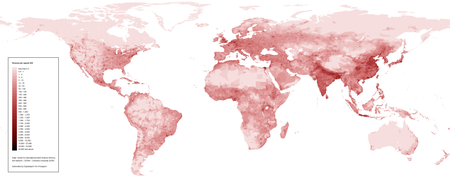
Population density is the number of people per unit of area, usually transcribed as "per square kilometer" or square mile, and which may include or exclude, for example, areas of water or glaciers. Commonly this is calculated for a county, city, country, another territory or the entire world.
The world's population is around 8,000,000,000 [3] and the Earth's total area (including land and water) is 510,000,000 km2 (200,000,000 sq mi). [4] Therefore, the worldwide human population density is approximately 8,000,000,000 ÷ 510,000,000 = 16/km2 (41/sq mi). However, if only the Earth's land area of 150,000,000 km2 (58,000,000 sq mi) is taken into account, then human population density is 53/km2 (140/sq mi). This includes all continental and island land area, including Antarctica. However, if Antarctica is excluded, then population density rises to over 58 per square kilometre (150/sq mi). [1]

The European Commission's Joint Research Centre (JRC) has developed a suite of (open and free) data and tools named the Global Human Settlement Layer (GHSL) to improve the science for policy support to the European Commission Directorate Generals and Services and as support to the United Nations system. [5]
Several of the most densely populated territories in the world are city-states, microstates and urban dependencies. [6] [lower-alpha 1] In fact, 95% of the world's population is concentrated on just 10% of the world's land. [7] These territories have a relatively small area and a high urbanization level, with an economically specialized city population drawing also on rural resources outside the area, illustrating the difference between high population density and overpopulation.
Deserts have very limited potential for growing crops as there is not enough rain to support them. Thus, their population density is generally low. However, some cities in the Middle East, such as Dubai, have been increasing in population and infrastructure growth at a fast pace. [8]

Cities with high population densities are, by some, considered to be overpopulated, though this will depend on factors like quality of housing and infrastructure and access to resources. [10] Very densely populated cities are mostly in Asia (particularly Southeast Asia); Africa's Lagos, Kinshasa, and Cairo; South America's Bogotá, Lima, and São Paulo; and Mexico City and Saint Petersburg also fall into this category. [11]

City population and especially area are, however, heavily dependent on the definition of "urban area" used: densities are almost invariably higher for the center only than when suburban settlements and intervening rural areas are included, as in the agglomeration or metropolitan area (the latter sometimes including neighboring cities).
In comparison, based on a world population of 7.8 billion, the world's inhabitants, if conceptualized as a loose crowd occupying just under 1 m2 (10 sq ft) per person (cf. Jacobs Method), would occupy a space a little larger than Delaware's land area.[ citation needed ]
| Rank | Country or dependent territory | Land Area | Population | Density | ||
|---|---|---|---|---|---|---|
| km2 | sq mi | per km2 | per sq mi | |||
| 1 | 30.5 | 12 | 650,834 | 21,339 | 55,268 | |
| 2 | 2.02 | 0.78 | 37,550 | 18,589 | 48,145 | |
| 3 | 719.9 | 278 | 5,612,300 | 7,796 | 20,192 | |
| 4 | 1,106.3 | 427 | 7,409,800 | 6,698 | 17,348 | |
| 5 | 365 | 141 | 2,098,389 | 5,749 | 14,890 | |
| 6 | 6.8 | 2.6 | 33,140 | 4,874 | 12,624 | |
| 7 | 757 | 292 | 1,451,200 | 1,917 | 4,965 | |
| 8 | 0.44 | 0.17 | 800 | 1,818 | 4,709 | |
| 9 | 315 | 122 | 475,701 | 1,510 | 3,911 | |
| 10 | 298 | 115 | 378,114 | 1,269 | 3,287 | |
| Rank | Country/Territory | Land Area | Population | Density | ||
|---|---|---|---|---|---|---|
| km2 | sq mi | per km2 | per sq mi | |||
| 1 | 134,208 | 51,818 | 170,329,768 | 1,269 | 3,287 | |
| 2 | 32,260 | 12,456 | 23,539,588 | 730 | 1,891 | |
| 3 | 24,668 | 9,524 | 13,246,394 | 537 | 1,391 | |
| 4 | 33,670 | 13,000 | 17,943,243 [12] | 533 | 1,380 | |
| 5 | 99,909 | 38,575 | 51,439,038 | 515 | 1,334 | |
| 6 | 25,680 | 9,915 | 12,574,571 | 490 | 1,269 | |
| 7 | 2,973,190 | 1,147,955 | 1,374,547,140 | 462 | 1,197 | |
| 8 | 27,560 | 10,641 | 11,743,017 | 426 | 1,103 | |
| 9 | 30,278 | 11,690 | 11,554,449 | 382 | 989 | |
| 10 | 298,170 | 115,124 | 109,961,895 | 369 | 956 | |
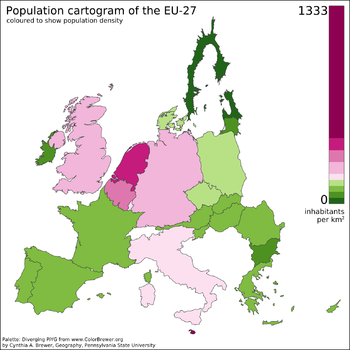

Although the arithmetic density is the most common way of measuring population density, several other methods have been developed to provide alternative measures of population density over a specific area.

Denmark is a Nordic country located in Northern Europe. It consists of the Jutland Peninsula and several islands in the Baltic Sea, referred to as the Danish Archipelago. Denmark is located southwest of Sweden and due south of Norway and is bordered by the German state Schleswig-Holstein to the south, with a 68 kilometres long land border.

An urban area, built-up area or urban agglomeration is a human settlement with a high population density and an infrastructure of built environment. This is the core of a metropolitan statistical area in the United States, if it contains a population of more than 50,000.

Leduc County is a municipal district in Alberta, Canada that is immediately south of the City of Edmonton. It spans 105 km (65 mi) east to west and 32 km (20 mi) north to south, and has a population of 14,416. The municipal district is home to prairie parkland and several lakes and is home to the Edmonton International Airport, the Nisku Industrial Business Park and the Genesee Generating Station.

The Rural Municipality of Wreford No. 280 is a rural municipality (RM) in the Canadian province of Saskatchewan within Census Division No. 11 and SARM Division No. 5. Located in the south-central portion of the province, it is north of the city of Regina.

Lacombe County is a municipal district in central Alberta, Canada. It is within Census Division No. 8 north of the City of Red Deer. Its municipal office is 4 km (2.5 mi) west of Highway 2 and the City of Lacombe, and 6 km (3.7 mi) east of the Summer Village of Gull Lake, at the intersection of Highway 12 and Spruceville Road.
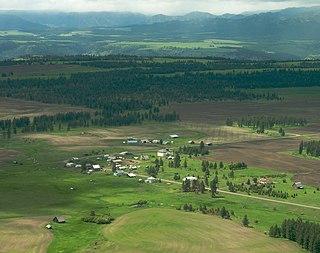
In geography, statistics and archaeology, a settlement, locality or populated place is a community of people living in a particular place. The complexity of a settlement can range from a minuscule number of dwellings grouped together to the largest of cities with surrounding urbanized areas. Settlements include hamlets, villages, towns and cities. A settlement may have known historical properties such as the date or era in which it was first settled, or first settled by particular people. The process of settlement involves human migration.

The Rural Municipality of Hudson Bay No. 394 is a rural municipality (RM) in the Canadian province of Saskatchewan within Census Division No. 14 and SARM Division No. 4. At 12,462 km2 (4,812 sq mi) in area, it is the largest rural municipality in Saskatchewan. It is in the northeast-central portion of the province.

The Rural Municipality of The Gap No. 39 is a rural municipality (RM) in the Canadian province of Saskatchewan within Census Division No. 2 and SARM Division No. 2.
Killaly is a village in the Canadian province of Saskatchewan within the Rural Municipality of Grayson No. 184 and Census Division No. 5. The village is located 23 km south of the City of Melville on Highway 47 at the intersection of Highway 22 and 47, and only 17 minutes north of Crooked Lake.

Bradwell is a village in the Canadian province of Saskatchewan within the Rural Municipality of Blucher No. 343 and Census Division No. 11. The village is located about 36 kilometres (22 mi) southeast of the city of Saskatoon on Highway 763. In 1936, during gravel excavations for a highway, the partial skeleton of a neolithic human male were discovered and named "Bradwell Man". A stone scraper and some eagle talons were found nearby.
Edenwold is a village in the Canadian province of Saskatchewan within the Rural Municipality of Edenwold No. 158 and Census Division No. 6. It is located 45 km (28 mi) north of the City of Regina.
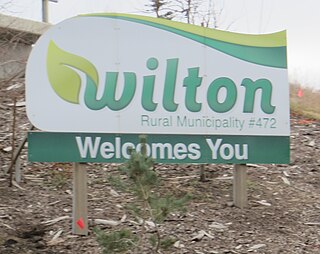
The Rural Municipality of Wilton No. 472 is a rural municipality (RM) in the Canadian province of Saskatchewan within Census Division No. 17 and SARM Division No. 6. It is located in the west-central portion of the province.
Aetna is a hamlet in southern Alberta, Canada within Cardston County, located 2 kilometres (1.2 mi) east of Highway 2, approximately 70 kilometres (43 mi) southwest of Lethbridge.
Cluny is a hamlet in Alberta, Canada within Wheatland County. It is 3 kilometres (1.9 mi) south of Highway 1 on a Canadian Pacific Kansas City railway line and Highway 843, approximately 87 kilometres (54 mi) southeast of Calgary. It has an elevation of 570 metres (1,870 ft).

Pincher Station, once known as Pincher City, is a hamlet in southern Alberta, Canada within the Municipal District of Pincher Creek No. 9. It is located on Highway 3, approximately 83 kilometres (52 mi) southwest of Lethbridge. Previously an incorporated community, Pincher City dissolved from village status on May 3, 1932.

The Rural Municipality of Redburn No. 130 is a rural municipality (RM) in the Canadian province of Saskatchewan within Census Division No. 6 and SARM Division No. 2. It is located southeast of the city of Moose Jaw in the south-central portion region of the province.
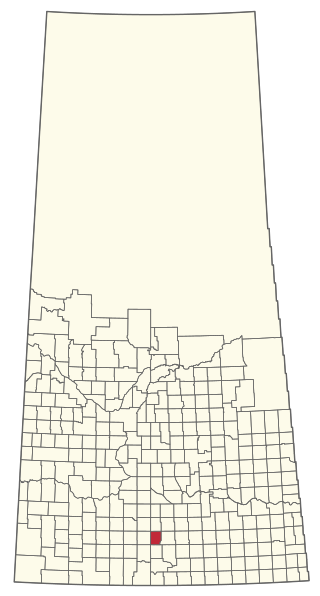
The Rural Municipality of Lake Johnston No. 102 is a rural municipality (RM) in the Canadian province of Saskatchewan within Census Division No. 3 and SARM Division No. 2. Located in the southwest portion of the province, it is north of the town of Assiniboia and south of the city of Moose Jaw.
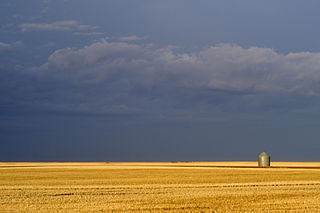
The Rural Municipality of Weyburn No. 67 is a rural municipality (RM) in the Canadian province of Saskatchewan within Census Division No. 2 and SARM Division No. 1. It is located in the southeast portion of the province.
exploratory map shows data from the [...] Global Human Settlement Layer (GHSL) produced by the European Commission JRC and the CIESIN Columbia University